The approach to planning and deploying fiber networks can vary dramatically between rural and urban environments. While modern fiber design software has revolutionized how providers tackle these challenges, the differences in these environments require carefully tailored, data-driven strategies to maximize ROI, reduce deployment risks, and accelerate time to market.
Initial planning
The first step in any network deployment is determining where and how to build. Current fiber coverage statistics tell an important story: urban areas lead with around 62% fiber access, followed by suburban areas at 49%, while rural areas lag at 31%.1 These disparities reflect not just deployment challenges but also the complex economics of different population densities.
Urban environments present a dense, complex landscape where fiber design software becomes essential for mapping existing infrastructure and planning efficient routes. These tools help planners navigate around existing utilities, buildings, and other obstacles while maximizing the number of serviceable locations per mile of fiber. In urban areas with more than 50 homes per mile, planners must carefully justify the higher median underground deployment cost of $23.25 per foot.1
Rural planning, by contrast, focuses more on optimizing coverage across vast areas with scattered populations of less than 5 homes per mile. While using the same fiber design software, rural planners work with a lower median underground deployment cost of $12.50 per foot but must cover significantly more distance to reach fewer customers.1 The cost relationship with density continues through suburban areas ($14.59/ft) and standard rural areas ($14.63/ft), demonstrating how population density directly impacts deployment strategies.
Deployment strategies and costs
The deployment phase is where we see the most significant cost variations between construction methods and environments. Understanding the cost composition is crucial for effective planning. Labor represents the largest component, accounting for 73% of underground build costs and 67% of aerial deployments. Materials make up the remainder at 27% and 33% respectively. Beyond these direct costs, engineering typically accounts for 2-10% of total project costs, while permitting averages are around 10%.1
Advanced fiber design software helps planners optimize these costs by identifying the most efficient routes and construction methods. In urban deployments, this often means coordinating complex construction schedules and managing multiple crews working in close proximity. Rural deployments face different challenges, requiring optimization for coverage across vast distances while minimizing the impact of low population density on cost per customer.
Customer connection costs
The final connection to individual premises, known as the "drop," varies significantly by environment and method.

- Urban areas: Shorter drops but higher costs due to infrastructure complexity
- Rural areas: Longer drops with simpler construction requirements
- Cost impact: Fiber design software helps forecast total project costs based on these variables
Network management and operations
Operational challenges vary significantly between environments. In urban areas, the focus is on managing high capacity demands and rapid response to service issues. Modern fiber design software plays a crucial role here, helping operators monitor network performance and plan maintenance across densely populated areas.
Aerial deployments introduce unique operational considerations, particularly regarding make-ready costs. These can add $5-6 per foot to the overall deployment cost, with individual pole preparation ranging from $500 to $5,000 depending on required modifications.1 These costs impact both urban and rural deployments but often affect rural projects more significantly due to the longer distances involved.
Equity and accessibility considerations
Both environments face unique challenges in ensuring equitable access to broadband services. The stark contrast in current fiber availability—62% in urban areas versus 31% in rural areas—highlights the ongoing need for targeted solutions. Urban deployments must address issues of building access and affordable service options, while rural deployments focus more on basic access, often requiring government support through programs like the Broadband Equity, Access, and Deployment Program or BEAD to make service economically viable.2
Success in either environment requires understanding and adapting to its unique characteristics. The significant cost variations between urban and rural deployments demonstrate the need for environment-specific strategies. Organizations planning fiber networks must carefully consider these differences when developing their deployment strategies, choosing appropriate tools, and allocating resources.
Whether urban or rural, successful deployments require thorough planning, appropriate tools, and a deep understanding of the local environment's unique challenges and opportunities. The key lies in selecting the right approaches while maintaining focus on long-term sustainability and service quality.
Citations:
1Fiber Broadband Association, “2024 Fiber Deployment Cost Annual Report”, December 2024, https://fiberbroadband.org/resources/2024-fiber-deployment-cost-annual-report/
2National Telecommunications and Information Administration, “Broadband Equity Access and Deployment (BEAD) Program,” BroadbandUSA, accessed February 24, 2025, https://broadbandusa.ntia.doc.gov/funding-programs/broadband-equity-access-and-deployment-bead-program




